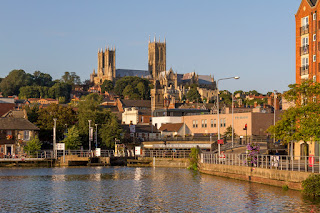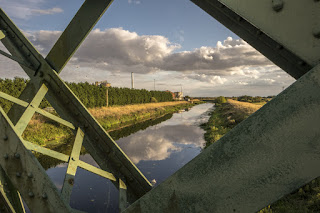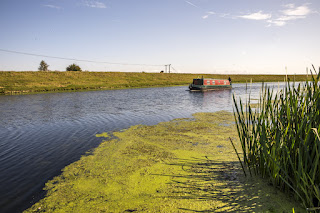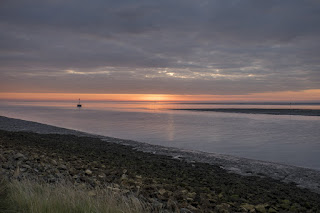Assignment
2: The River
My
body of work for Assignment 2 is about The River Witham. I grew up its banks, travelled to Lincoln,
Boston and Kings Cross on steam hauled and, later, diesel trains by it, fished
in it, collected train numbers by it, ran in cross-country races beside it and
swam in it. I see the river as a
metaphor for life; mine and the river's. The journey of the river is a poignant
reminder of the transience of human life, when compared to that of the river as
it flows out to sea to continue its infinite life.
Not
only does the river have its own current life, it has been influenced by the
hand of man for over 2000 years. More prehistoric
weapons and tools have been found in the Witham than any other UK river, apart
from the Thames (The Collection, Lincoln). 2500 years ago the river may have
been regarded as a sacred place by the people who lived here. Perhaps the still, marshy pools with their
reflections may have acted as mirrors to the heavens or as portals to the
underworld. These tools and weapons,
many beautifully decorated, were not just thrown away, but deliberately placed
there as offerings to the gods or for the leaders to demonstrate their wealth
(The Collection, Lincoln). Some of these
treasures can be seen in the Collection in Lincoln, including the Fiskerton Log
Boat, but the most famous is the Witham Shield made of iron, inlaid with
bronze, now in the British Museum (although there is a replica in The
Collection).
Whilst
photographing for this assignment I have researched photographers who have,
themselves photographed rivers: Alec Soth's Sleeping
by the Mississippi (2004), Jem Southam's
The Red River(1982-1989) and
Andreas Muller-Pohle's The Danube Project
(2005-2006). I have recorded my
observations about these photographers in my blog under Reading and Research
17. 18 and 19. I find that each of them
has relevance to my work and have found inspiration from them, more especially for how I intend to develop
the project.
Although
a few of the images in this assignment have been taken in softer more
topographic lighting, many have been taken in bright sunny weather often with
white, fluffy clouds; perfect for picturesque photography. Many authors are highly critical of the
picturesque as it portrays an idealised, romantic view of the countryside. A view, which it can be argued, does not
exist. Graham Clarke (1997) is critical
when he writes that English tourists took up photography and, using a romantic picturesque style, idealised the countryside. Established practitioners such as Roger
Fenton, he says, rarely showed evidence of work. Jesse Alexander (2015) argues
that the picturesque is prevalent in the postcard industry and these
photographs idealise the countryside. He
suggested viewpoints are marked on maps in the same way that William Gilpin did
in the 1700s with his picturesque tourist guides, even suggesting that they
take their Claude Glasses with them. Alexander
(2015) also quotes Fay Godwin who stated
on a 1986 Southbank show that
she was very wary of picturesque pictures as they are a very soft, warm blanket
of sentiment, which covers everybody's idea about the countryside, idealising it in a very unreal way (Godwin,
1986). Liz Wells (2011) agrees when arguing
that there are 'no storm clouds to interrupt the welcoming picturesque' in
these postcards. Alexander (2015) also writes of Constable's painting The Haywain arguing that it shows an
idealised view of the countryside and continues to argue that
picturesque imagery gives a romanticised and idealistic view of the land,
offering only a limited and superficial view and suggests that it panders to a
compulsive, escapist view. In this he
agrees with Wells (2011) who argues that 'the picturesque continues to manifest
itself in signposted 'photo-opportunities', encouraging tourists to take
pictures from spots that facilitate conventional Cartesian aesthetics.
On
the other hand authors also write in defence of
the picturesque. Bate (2009), although
agreeing with the criticisms of others, argues that it can be valued positively
as it gives people pleasure and fulfils a social function. People enjoy picturesque images as they
represent the composition and order that they would like to see in their own
lives. Malcolm Andrews (1999)
argues that people may be genetically programmed to prefer the 'ideal,
picturesque landscapes' of Capability Brown, because they resemble the savannah
scenery first settled by early man as they allow both predator and prey a good
view of food or danger. Andrews (1999) also informs us that, in Italy in the 1500s,
the landed gentry liked to enjoy picturesque landscapes as an antidote to the
rapid urbanisation of the country, so not just a phenomenon of today. Wells (2011) also makes this point. Andrews (1999) tells us, in defence of the
picturesque, that awesome and beautiful landscapes can detoxify the mind and
spirit.
My
reading suggests to me that, although a defence can be made for the
picturesque, on the whole it is not highly regarded. Knowing this I was happy to use some
picturesque imagery in this assignment, not because I agree with a Victorian
Romantic picturesque point of view, but because it suited the narrative style
of the project and a mix of overtly picturesque and some images less so
reflected the up and down nature of the river's history and of human lives. One or two images are of my childhood playground, when, my memory tells me, the sun always always shone. As Glynn Wilson (2012) states in the New
American Journal a river may be viewed as the ultimate metaphor for life.
Research
into the work of painters depicting the Witham has also been useful and I have
recorded this in my blog under Reading and Research 20.
References and
Bibliography
Alexander,
J. (2015) Perspectives on Place, London, Bloomsbury
Andrews, M. (1999) Landscape and
Western Art. London: Oxford University Press
Bate,
D. (2009) Photography, The Key Concepts, London, Bloomsbury
Boyes,
J. & Russell, R. (1977) The Canals of
Eastern England London, David and
Charles
British
Waterways, Lincolnshire County Council and the Environment Agency information
boards
Clarke, G. (1997) The Photograph. Oxford: Oxford University Press
Godwin,
F. (1986) Southbank Show. Cited in Alexander, J.A.P. (2015) Perspectives on
Place: Theory and Practice in Landscape
Photography. London: Bloomsbury
Hunt, N. (2014) Walking the Woods and the Water, London, Nicholas
Brealey Publishing
Leigh
Fermor, P (1977) A Time of Gifts, London, John Murray
Leigh
Fermor, P. (1986) Between the Woods and The Water, London, John Murray
Muller-Pohle,
A. (2005/06) The Danube River Project [online] andreas mullerphole
website. Available from: http://www.muellerpohle.net/projects.html
[Accessed 27.10.15]
Nicholson(2006)
Nicholson Waterways Guide (Vol 6) London,
Harper Collins
Sloth, A. (2004) Sleeping by
the Mississipi [online] Alec Soth website Available from: http://alecsoth.com/photography/?page_id=14
[Accessed 27.10.15]
Southam,
J. (1982-1989) The Red River [online] Landscape Stories website. Available
from:
http://www.landscapestories.net/issue-12/ls_12-001-jem-southam-the-red-river?lang=en
[Accessed 25.10.15]
The
Collection, Lincoln
Wells, L. (2011) Land Matters: Landscape Photography, Culture and Identity.
London, I.B.Tauris
Wilson,
G. (2012) The Ultimate Metaphor: Life is
Like a River [online] The Locust Fork News Journal. Available from:
http://blog.locustfork.net/2012/11/the-ultimate-metaphor-life-is-like-a-river/





























No comments:
Post a Comment